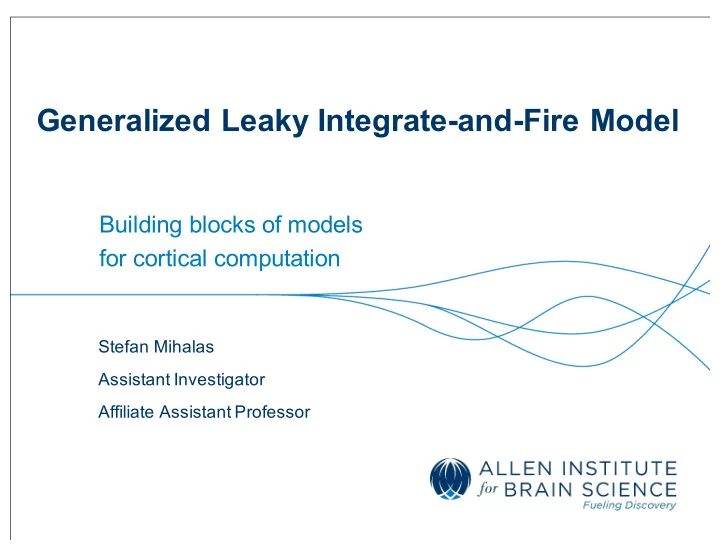

Generalized Leaky Integrate-and-Fire Model Building blocks of models for cortical computation Stefan Mihalas Assistant Investigator Affiliate Assistant Professor
Lecture plan 1. Motivation: why we study mouse cortex 2. Single neuron models: From dynamical systems to hybrid systems 3. Generalized leaky integrate-and-fire model 4. Fitting GLIF models 5. Cell classification using GLIF models alleninstitute.org | brain- 2 map.org
1. Why study cortex? Cerebral cortex can vary in size Herculano-Houzel (2012) PNAS 3
Cerebral cortex can vary in size Perrenoud, 2012 4
But the basic microstructure is very similar across areas Adult V1 Adult M1 Infant Ramon y Cahal, 1911 5
And across species Hill and Walsh, Nature 2005 6
Cortical column computations Hope: • Cortical columns implement canonical computations • The function of the cortex arises from a hierarchical organization of such computations alleninstitute.org | brain- 7 map.org
Constructing minimalistic models which reproduce a desired function Single neuron activity Activity in local circuits Mesoscopic models
Long term goal: Integrate models across scales into a model of cortical computation in the mouse visual system Single neuron activity Activity in local circuits Mesoscopic models
In Vitro single neuron models Single neuron activity Activity in local circuits Mesoscopic models
2. Why spiking models? • Time scale separation of the subthreshold vs spiking dynamics fast fast slow slow 20 mV 20 mV 2 ms -79 mV 400 ms -78 mV 200 pA steps 100 pA mean amplitude, 0.2 CV • Spikes are stereotyped 11
3. Generalized Leaky Integrate and Fire Models after-spike currents (ASC) I j (t) I j (t) membrane potential reset (R) I e (t) V(t) spike? threshold adaptation Θ V (t) (TA) Θ s (t) threshold reset (R) Mihalas and Niebur 2009 12 Corinne Teeter, Stefan Mihalas
Leaky Integrate and Fire Models membrane potential reset (R) I e (t) V(t) spike? Dynamics: between spikes Reset: if
LIF with reset rules membrane potential reset (R) I e (t) V(t) spike? Θ s (t) threshold reset (R) Dynamics: between spikes Reset: if
LIF with after-spike currents - optimization after-spike currents (ASC) I j (t) I j (t) I e (t) V(t) spike? Dynamics: between spikes Reset: if
LIF with after-spike currents after-spike currents (ASC) I j (t) I j (t) I e (t) V(t) spike? Dynamics: between spikes Reset: if
LIF with after-spike currents and voltage dependent threshold after-spike currents (ASC) I j (t) I j (t) membrane potential reset (R) I e (t) V(t) spike? Θ s (t) threshold reset (R) Dynamics: between spikes Reset: if
LIF with after-spike currents and voltage dependent threshold after-spike currents (ASC) I j (t) I j (t) membrane potential reset (R) I e (t) V(t) spike? Θ s (t) threshold reset (R)
LIF with after-spike currents spiking and voltage dependent threshold after-spike currents (ASC) I j (t) I j (t) membrane potential reset (R) I e (t) V(t) spike? threshold adaptation (TA) Θ V (t) Θ s (t) threshold reset (R) Dynamics: between spikes Reset: if
LIF with after-spike currents spiking and voltage dependent threshold after-spike currents (ASC) I j (t) I j (t) membrane potential reset (R) I e (t) V(t) spike? threshold adaptation (TA) Θ V (t) Θ s (t) threshold reset (R)
4. Allen Cell Types Database Search and Cell Positions in Common Summary of Cell Filter Options Coordinate Framework Characteristics ( Click for additional details ) 2 Jim Berg, Hongkui Zeng alleninstitute.org | brain-map.org 1
Excitatory layer 2/3/4 layer 4 layer 4 layer 4 neurons Cux2-CreERT2 Nr5a1-Cre Scnn1a-Tg3-Cre Rorb-IRES2-Cre layer 5 layer 6 pan-excitatory Genetic Markers via Cre Lines Rbp4-Cre Ntsr1-Cre Slc17a6-IRES-Cre Inhibitory neurons Pvalb-2A-Flpo; Slc32a1-IRES-Cre Sst-IRES-Cre Vip-IRES-Cre pan-inhibitory 2 Nos1-CreERT2 Calb2-IRES-Cre Gad2-IRES-Cre Julie Harris 2
Electrophysiology Protocol Adaptive Naturalistic Instantaneous Subthreshold, Rheobase threshold response threshold & Suprathreshold 20 mV 20 mV 50 ms 2 ms -78 mV -79 mV 200 pA steps 20 mV 20 mV 400 ms 400 ms -78 mV -79 mV 100 pA 100 pA mean amplitude, 0.2 CV 2 3
Leaky Integrate and Fire Models - optimization membrane potential reset (R) I e (t) V(t) spike? 24
LIF with reset rules - optimization membrane potential reset (R) I e (t) V(t) spike? Θ s (t) threshold reset (R)
LIF R ASC AT - optimization after-spike currents (ASC) I j (t) I j (t) membrane potential reset (R) I e (t) V(t) spike? threshold adaptation (TA) Θ V (t) Θ s (t) threshold reset (R)
LIF R ASC AT – optimization Maximum likelihood based on internal noise (MLIN)
Generalized Leaky Integrate and Fire Models Training Data Test Data Explained Variance LIF LIF- R LIF- ASC LIF- R- ASC LIF- R- ASC -TA 28
Average explained variance • Glif 5: 75% - excitatory 84% for inhibitory • Biophysical perisomatic – 65% • Biophysical all-active – 69% 29
Defining cell types based on models 30
31
Single Cell Type Models Conclusion • A large diversity of neurons can be characterized and modeled • GLIF models still outperform detailed biophysical ones due to individual recording length limitation • Parameters in GLIF models can be used to classify cell types • visit our website: http://www.brain-map.org/ alleninstitute.org | brain- 3 map.org 2
Recommend
More recommend